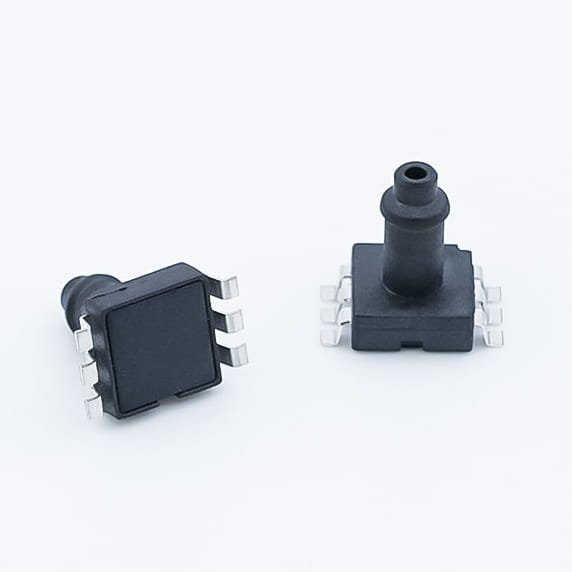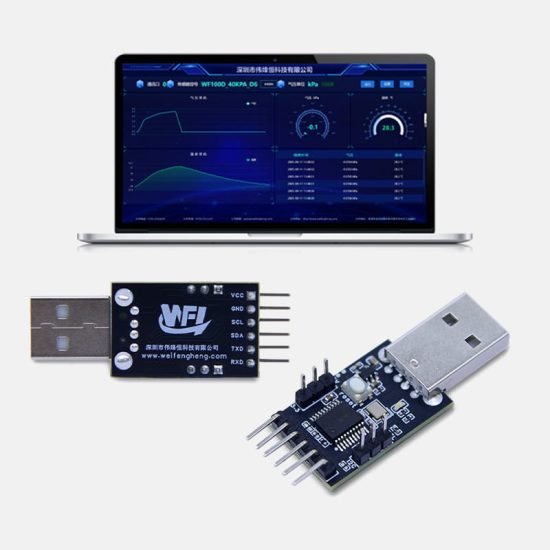كتالوج
The packaging type of MEMS pressure sensors directly affects their performance and application adaptability. The market primarily features three compensation types of packaging: uncompensated, passively compensated, and fully compensated. Each packaging type employs different signal processing methods to address temperature drift and nonlinearity issues. Uncompensated packaging offers the lowest cost but requires external calibration, passively compensated types perform well in room temperature environments, while fully compensated types achieve precise compensation across wide temperature ranges through integrated ASIC chips. Understanding the technical characteristics of these three packaging types is crucial for engineers selecting appropriate sensor solutions.

1. Uncompensated MEMS Pressure Sensor Packaging
Basic Package Structure Characteristics
Uncompensated pressure sensors represent the most basic packaging form, with the MEMS silicon chip still at their core. This packaging type uses standard SOP6, DIP6, or U6 package forms, containing only the pressure-sensitive MEMS chip internally without any integrated signal conditioning circuits. Each chip’s output is unique, meaning even sensors from the same production batch will have different output characteristics. Sensors in this packaging form typically require external circuits for signal amplification and conditioning.
Output Characteristics and Calibration Requirements
Uncompensated package sensors directly output raw signals from the MEMS chip, which typically have significant offset and temperature dependency. Without built-in compensation mechanisms, each sensor requires individual calibration processes to determine accurate output characteristics. Engineers must add external amplifiers, filters, and calibration circuits in application circuits to obtain usable output signals. While this approach increases system complexity, it provides users with maximum design flexibility.
Cost-Benefit Analysis
From a cost perspective, uncompensated packaging has clear advantages. Manufacturing costs are significantly reduced by eliminating built-in signal processing circuits. However, this cost advantage must be weighed at the system level, as users need to invest additional time and resources in designing external compensation circuits. For high-volume applications or projects extremely sensitive to cost, uncompensated packaging remains an economically practical choice.

2. Passively Compensated MEMS Pressure Sensor Packaging
Temperature Compensation Mechanism
Passively compensated packaging is a solution optimized for room temperature applications, particularly suitable for use within 10°C to 40°C operating temperature ranges. This packaging type adds simple passive compensation circuits based on the MEMS chip, using resistor networks or other passive components to counteract temperature effects on sensor output. While passive compensation mechanisms are less precise than active compensation, they can provide adequate accuracy assurance within limited temperature ranges.
Application Scenario Adaptability
Passively compensated packaging primarily targets indoor environments or applications with relatively stable temperature changes. In these environments, temperature fluctuations are small, and passive compensation can effectively reduce the impact of temperature drift on measurement accuracy. This packaging type performs excellently in automotive interiors, home appliances, office equipment, and similar applications, avoiding the complex calibration issues of uncompensated types while avoiding the high costs of fully compensated types.
Performance Balance Considerations
Passively compensated packaging achieves good balance between performance and cost. Although its temperature compensation range is limited, it can provide stable and reliable output within specified operating ranges. For applications that don’t require operation under extreme temperature conditions, passively compensated packaging offers a practical middle choice, simplifying system design while controlling overall costs.
3. Fully Compensated MEMS Pressure Sensor Packaging
ASIC Integration Technology
Fully compensated packaging represents the highest level of current MEMS pressure sensor technology. This packaging internally integrates MEMS pressure-sensitive chips and dedicated ASIC chips, using digital signal processing technology to comprehensively compensate for offset, sensitivity, temperature drift, and nonlinearity of pressure-sensitive chips. The ASIC chip uses supply voltage as reference, generating calibrated and temperature-compensated standard voltage signals with excellent linearity and temperature stability.
Wide Temperature Range Performance
Fully compensated packaging can maintain high-precision output across -40°C to 85°C or even wider temperature ranges. Within such wide temperature ranges, sensors’ total error band can be controlled within ±1% of full-scale output, far superior to passively compensated and uncompensated packaging. This performance makes fully compensated packaging particularly suitable for aerospace, industrial automation, automotive engine management, and other applications requiring extremely high precision.
Power Supply and Interface Characteristics
Fully compensated MEMS pressure sensors typically use 3.3V to 5.5V wide voltage supply ranges with good power adaptability. Many products also feature anti-slip pneumatic nozzle structures, improving mechanical connection reliability. Standardized voltage output interfaces simplify system integration processes, allowing engineers to directly connect sensor outputs to analog-to-digital converters or microcontrollers without additional signal conditioning circuits.
4. Performance Advantages and Adaptability Analysis
Precision Measurement Tools and Methods
Evaluating pressure sensor packaging performance requires professional testing equipment. Pressure accuracy measurement typically uses high-precision pressure calibrators like WF100S series SOP series pressure calibrators, providing 0.02% full-scale accuracy baselines. Temperature compensation performance testing requires environmental test chambers like WF100DP or WF100E products, capable of precisely controlling temperatures from -55°C to 125°C. Resolution testing requires high-precision data acquisition systems like digital multimeters or data acquisition module.
Supplier Quality Assessment Standards
When selecting pressure sensor suppliers, focus on evaluating calibration certificate authority and test data completeness. Quality suppliers should provide NIST-traceable calibration certificates including detailed parameters like temperature coefficients, nonlinearity errors, and long-term stability. Suppliers should also have ISO 9001 quality management system certification and provide detailed production process control documentation. For fully compensated products, suppliers must have ASIC design and production capabilities or establish stable partnerships with renowned ASIC manufacturers.
Application Environment Matching Principles
Selecting appropriate packaging types requires comprehensive consideration of application environment temperature ranges, accuracy requirements, cost budgets, and development cycles. For applications with dramatic temperature changes or extreme high/low temperatures, fully compensated packaging is the only viable choice. Room temperature applications can consider passively compensated packaging, ensuring basic performance while controlling costs. For cost-sensitive applications capable of post-calibration, uncompensated packaging still has competitive advantages.
5. Technology Development Trends and Selection Recommendations
Package Technology Evolution Direction
Current MEMS pressure sensor packaging technology is advancing toward higher integration and greater intelligence. New-generation fully compensated packaging begins integrating digital interface functions like I2C or SPI communication protocols, further simplifying system integration. Simultaneously, package sizes continue shrinking while power consumption optimizes, providing better solutions for portable and IoT applications. Advanced packaging technology also introduces self-diagnostic functions, enabling real-time sensor status monitoring and anomaly reporting.
Selection Decision Framework
Engineers should establish systematic decision frameworks when selecting pressure sensor packaging types. First, evaluate application technical requirements including pressure range, accuracy level, operating temperature range, and response time. Then consider project constraints like cost budget, development cycle, production volume, and quality standards. Finally, analyze supply chain factors including supplier technical strength, product availability, technical support level, and long-term supply assurance.
Quality Control and Verification
Regardless of packaging type selection, comprehensive quality control and verification processes are essential. For uncompensated packaging, strict calibration procedures and production testing processes must be designed. Passively compensated packaging requires verification of performance stability within specified temperature ranges. Although fully compensated packaging comes factory-calibrated, sampling verification and regular performance monitoring are still needed to ensure product quality meets application requirements.
خاتمة
The three common MEMS pressure sensor packaging types each have distinct technical characteristics and applicable scenarios. Uncompensated packaging suits cost-sensitive high-volume applications with low-cost advantages but requires users to invest additional calibration work. Passively compensated packaging provides good performance-cost balance in room temperature environments, suitable for applications with relatively stable temperature changes. Fully compensated packaging achieves the highest performance level through integrated ASIC chips, maintaining excellent accuracy and stability across wide temperature ranges, making it the preferred solution for high-end applications. Engineers should comprehensively weigh specific application needs, technical requirements, and cost budgets when selecting, choosing the most suitable packaging type. As MEMS technology continues developing, pressure sensor packaging will evolve toward higher integration and greater intelligence, providing superior solutions for various industry applications.
The above introduction only scratches the surface of the applications of pressure sensor technology. We will continue to explore the different types of sensor elements used in various products, how they work, and their advantages and disadvantages. If you’d like more detail on what’s discussed here, you can check out the related content later in this guide. If you are pressed for time, you can also click here to download the details of this guides منتجات استشعار ضغط الهواء PDF بيانات.
For more information on other sensor technologies, please قم بزيارة صفحة أجهزة الاستشعار لدينا.

